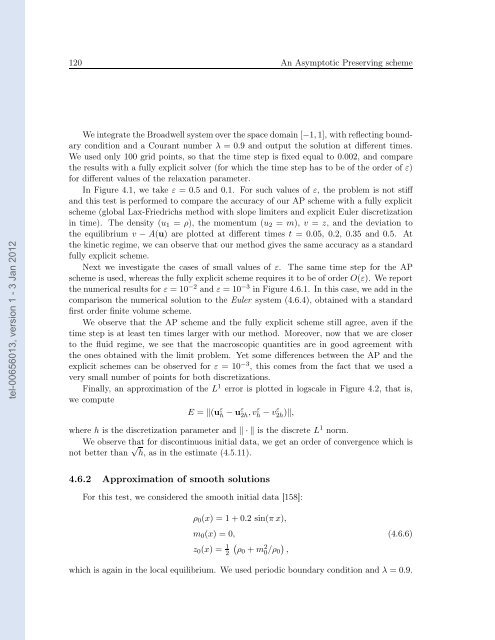Modélisation, analyse mathématique et simulations numériques de ...
Modélisation, analyse mathématique et simulations numériques de ...
Modélisation, analyse mathématique et simulations numériques de ...
Create successful ePaper yourself
Turn your PDF publications into a flip-book with our unique Google optimized e-Paper software.
tel-00656013, version 1 - 3 Jan 2012<br />
120 An Asymptotic Preserving scheme<br />
We integrate the Broadwell system over the space domain[−1,1], with reflecting boundary<br />
condition and a Courant number λ = 0.9 and output the solution at different times.<br />
We used only 100 grid points, so that the time step is fixed equal to 0.002, and compare<br />
the results with a fully explicit solver (for which the time step has to be of the or<strong>de</strong>r of ε)<br />
for different values of the relaxation param<strong>et</strong>er.<br />
In Figure 4.1, we take ε = 0.5 and 0.1. For such values of ε, the problem is not stiff<br />
and this test is performed to compare the accuracy of our AP scheme with a fully explicit<br />
scheme (global Lax-Friedrichs m<strong>et</strong>hod with slope limiters and explicit Euler discr<strong>et</strong>ization<br />
in time). The <strong>de</strong>nsity (u1 = ρ), the momentum (u2 = m), v = z, and the <strong>de</strong>viation to<br />
the equilibrium v − A(u) are plotted at different times t = 0.05, 0.2, 0.35 and 0.5. At<br />
the kin<strong>et</strong>ic regime, we can observe that our m<strong>et</strong>hod gives the same accuracy as a standard<br />
fully explicit scheme.<br />
Next we investigate the cases of small values of ε. The same time step for the AP<br />
scheme is used, whereas the fully explicit scheme requires it to be of or<strong>de</strong>r O(ε). We report<br />
the numerical results for ε = 10 −2 and ε = 10 −3 in Figure 4.6.1. In this case, we add in the<br />
comparison the numerical solution to the Euler system (4.6.4), obtained with a standard<br />
first or<strong>de</strong>r finite volume scheme.<br />
We observe that the AP scheme and the fully explicit scheme still agree, aven if the<br />
time step is at least ten times larger with our m<strong>et</strong>hod. Moreover, now that we are closer<br />
to the fluid regime, we see that the macroscopic quantities are in good agreement with<br />
the ones obtained with the limit problem. Y<strong>et</strong> some differences b<strong>et</strong>ween the AP and the<br />
explicit schemes can be observed for ε = 10 −3 , this comes from the fact that we used a<br />
very small number of points for both discr<strong>et</strong>izations.<br />
Finally, an approximation of the L 1 error is plotted in logscale in Figure 4.2, that is,<br />
we compute<br />
E = (u ε h −uε 2h ,vε h −vε 2h ),<br />
where h is the discr<strong>et</strong>ization param<strong>et</strong>er and · is the discr<strong>et</strong>e L 1 norm.<br />
We observe that for discontinuous initial data, we g<strong>et</strong> an or<strong>de</strong>r of convergence which is<br />
not b<strong>et</strong>ter than √ h, as in the estimate (4.5.11).<br />
4.6.2 Approximation of smooth solutions<br />
For this test, we consi<strong>de</strong>red the smooth initial data [158]:<br />
ρ0(x) = 1+0.2 sin(πx),<br />
m0(x) = 0,<br />
<br />
ρ0 +m2 0 /ρ0<br />
<br />
,<br />
z0(x) = 1<br />
2<br />
(4.6.6)<br />
which is again in the local equilibrium. We used periodic boundary condition and λ = 0.9.

















